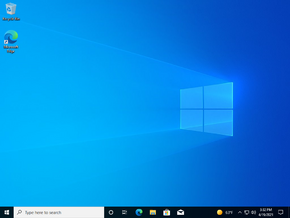Windows 10
| Version of Microsoft Windows | |
 | |
| Initial release | Windows 10 (29 July 2015) |
|---|---|
| Latest release | Windows 10 2022 Update (18 October 2022) |
| Supported platforms | x86, AMD64, ARM32 (ARMv7)[a], ARM64[b] |
| Preceded by | Windows 8.1 |
| Succeeded by | Windows 11 |
Windows 10 is a series of Microsoft Windows operating systems, first introduced in July 2015 after being announced in September 2014. It succeeded Windows 8.1 and was ultimately superseded by Windows 11 in October 2021. In April 2023, Microsoft announced that Windows 10 2022 Update would be the last version of Windows 10 as the series will reach end of support on 14 October 2025.[1]
A new release model called Windows as a service was introduced with smaller and regular feature updates, as opposed to releasing a major version of Windows every few years. Usually, these updates are a new build of the operating system, although in a few cases Microsoft released feature updates consisting of a limited set of new functionality using the regular cumulative update infrastructure. From 2017 to 2021, feature updates were released twice in a year, with the first feature update being released in spring and the other in fall. The schedule was realigned in 2021 in that feature updates for Windows 10 would be released annually in order to be consistent with Windows 11's new release cadence.[2]
The Windows Insider Program was also introduced with Windows 10, which boosted the company's engagement with beta testers as well as distributed new pre-release builds more frequently than the prior beta testing initiatives. This also greatly cut down the number of leaks from within the company, which in the past bothered the company due to legal complications of contracted features becoming available earlier than anticipated. However, while early Insider builds often contained some clearly unfinished features and did not attempt to hide them, the Windows team has gradually moved towards locking such features down using systems such as Velocity and only unlocking them in an almost finished state.
The Windows 10 series is the last to run on 32-bit x86 systems, as support for these has been ultimately removed with the original release of Windows 11. It is also the last to support the legacy PC/AT BIOS firmware even on 64-bit systems as Windows 11 now requires UEFI firmware with Secure Boot support, which has been a part of Microsoft requirements for newly designed devices since Windows 8.
List of feature updates[edit | edit source]
| Name | Version | Based on | Build no. | Release date | Support end date | ||||
|---|---|---|---|---|---|---|---|---|---|
| Consumer | Enterprise | LTSC | IoT LTSC | ||||||
| Windows 10 | 1507[c] | Threshold | 10240 | 2015-07-29 | 2017-05-09 | 2025-10-14 | |||
| Windows 10 November Update | 1511 | Threshold 2 | 10586 | 2015-11-10 | 2017-10-10 | — | — | ||
| Windows 10 Anniversary Update | 1607 | Redstone 1 | 14393 | 2016-08-02 | 2018-04-10 | 2019-04-09 | 2026-10-13 | ||
| Windows 10 Creators Update | 1703 | Redstone 2 | 15063 | 2017-04-11 | 2018-10-09 | 2019-10-08 | — | — | |
| Windows 10 Fall Creators Update | 1709 | Redstone 3 | 16299 | 2017-10-17 | 2019-04-09 | 2020-10-13 | — | — | |
| Windows 10 April 2018 Update | 1803 | Redstone 4 | 17134 | 2018-04-30 | 2019-11-12 | 2021-05-11 | — | — | |
| Windows 10 October 2018 Update | 1809 | Redstone 5 | 17763 | 2018-11-13 | 2020-11-10 | 2029-01-09 | |||
| Windows 10 May 2019 Update | 1903 | Titanium | 18362 | 2019-05-21 | 2020-12-08 | — | — | ||
| Windows 10 November 2019 Update | 1909 | Vanadium[3][d] | 18363[e] | 2019-11-12 | 2021-05-11 | 2022-05-10 | — | — | |
| Windows 10 May 2020 Update | 2004 | Vibranium[3][4] | 19041 | 2020-05-27 | 2021-12-14 | — | — | ||
| Windows 10 October 2020 Update | 20H2 | 19042[f] | 2020-10-20 | 2022-05-10 | 2023-05-09 | — | — | ||
| Windows 10 May 2021 Update | 21H1 | 19043[f] | 2021-05-18 | 2022-12-13 | — | — | |||
| Windows 10 November 2021 Update | 21H2 | 19044[f] | 2021-11-16 | 2023-06-13 | 2024-06-11 | 2027-01-12 | 2032-01-13 | ||
| Windows 10 2022 Update | 22H2 | 19045[f] | 2022-10-18 | 2025-10-14 | — | — | |||
|
Legend:
Old version
Older version, still supported
Current stable version
Latest preview version
Future release
| |||||||||
Notes[edit | edit source]
- ↑ For internal testing purposes, SysArm32 (ARM32 WOW64), and mobile only
- ↑ Proper Support for ARM64 was added in Windows 10 Fall Creators Update.
- ↑ Only numbered as version 1507 retroactively in documentation. The OS itself only reports as version 10.0.
- ↑ Vanadium is considered a distinct semester by Microsoft even though it is merely an update for version 1903 (Titanium).
- ↑ Based on build 18362; new features are enabled via an enablement package.
- ↑ 6.0 6.1 6.2 6.3 Based on build 19041; new features are enabled via an enablement package.
References[edit | edit source]
- ↑ https://techcommunity.microsoft.com/t5/windows-it-pro-blog/windows-client-roadmap-update-april-2023/ba-p/3805227
- ↑ https://blogs.windows.com/windowsexperience/2021/11/16/how-to-get-the-windows-10-november-2021-update/
- ↑ 3.0 3.1 https://www.zdnet.com/article/what-comes-after-windows-10-19h1-vanadium/
- ↑ https://web.archive.org/web/20191214130318/https://twitter.com/h0x0d/status/1125409514193281024
